Our story begins in 2014, and it is the story of a community of patients, who are fighting for Blue Cone Monochromatism to become a treatable disease. But the story begins long before 2014, within each of the families who are part of our community. It is the story of our maternal grandparents suffering from this form of low vision whose name they did not know before 1980s or of others before them, or of our father, of a brother, of a cousin or of an uncle and today of ourselves, our children and our grandchildren.
The history of our community today collects the history of all these families.
Yes, because a genetic disease linked to the X chromosome, which is Blue Cone Monochromatism, is a disease transmitted by female carriers and which affects the men of a family. A family with BCM has about 5 affected individuals per family, according to data from the International Patient Registry of BCM – www.BCMRegistry.org.
This is why we decided to include the word “families” in the name of our organization, because our community and its history are a mix of stories of many families. Each family, previously isolated and without a name for this disease, today has the possibility of arriving at the diagnosis and joining many others, taking action to achieve a cure through gene therapy.
Before May 2014, our President Renata Sarno had begun in 2010 to personally finance the work of some scientists, Dr. Samuel G. Jacobson at the Scheie Eye Institute in Philadelphia, PA, Dr. William W. Hauswirth at University of Florida, Gainesville, FL and Dr. Bernd Wissinger at the University of Tübingen in Germany, with the aim of understanding whether there are enough cells in the retina of a person with Blue Cone Monochromatism for a gene therapy treatment, which AAV vectors to use for therapy, and what all the causative mutations are. In May 2014, Renata Sarno, Kay McCrary and Barbara Sergent met in Gainesville, FL, during a meeting of an achromat association, and after founding the BCM Families Foundation in the State of Delaware, they had their first Board of Directors meeting, together with the lawyer who had dealt with the legal aspects of the constitution and drafting the Bylaws.
 May 2020 Gainesville, FL – First Board of Directors Meeting of the BCMFF
May 2020 Gainesville, FL – First Board of Directors Meeting of the BCMFF
During 2014 the Foundation obtained 501(c)(3) status from the IRS as well as collaborative contracts with the Universities of Pennsylvania and Florida, passed from Renata Sarno to the Foundation. Support for the University of Tübingen began in 2010 and continues through 2024 to ensure that all members of our community have free access to genetic testing. Genetic confirmation of the diagnosis is in fact a crucial point, which allows confirmation not only of the disease, but also of its genetic transmission and of the particular causative mutation. The BCM Families Foundation promotes the values of inclusion, diversity and equity, guaranteeing everyone the possibility of achieving a genetic diagnosis.
The history of our Foundation meets that of many scientists who have worked with us over time in the search for a cure. It is the story of Jeremy Nathans who at the end of the 1980s identified the genes responsible for the Monochromatism of Blue cones. We are grateful to Dr. Jeremy Nathans who today works at the John Hopkins School of Medicine in Baltimore, MD and who is part of our Scientific Advisory Board.
 Jeremy Nathans, M.D., Ph.D. Professor of Molecular Biology and Genetics, Neuroscience, Ophthalmology, The Johns Hopkins School of Medicine, Baltimore, MD
Jeremy Nathans, M.D., Ph.D. Professor of Molecular Biology and Genetics, Neuroscience, Ophthalmology, The Johns Hopkins School of Medicine, Baltimore, MD
In the 1980s he studied the genetics of color, that is, those genes that are responsible for the production of proteins that capture light, the opsin proteins. Those that capture red and green light are due to genes that are found one after the other, in « tandem », on the X chromosome, while those that produce the opsin proteins that capture blue light are found on chromosome 7 and have a different and independent genetic transmission. With much love and extraordinary support, Dr. Jeremy Nathans has attended the BCMFF SAB meetings and advised and supported many projects, including the BCM Patient Registry and the production of an animal model for BCM, on which he made a significant design contribution. In his studies on Blue Cone Monochromacy of the 80s we find some important names in the study of genetic eye diseases.


The history of the BCMFF owes much to another great scientist, whose history merged with ours. He is Dr. Samuel G. Jacobson of the University of Pennsylvania.
 Samuel G. Jacobson, M.D.,Ph.D. Professor of Ophthalmology, Director Center for Hereditary Retinal Degenerations and Retinal Function Department, Scheie Eye Institute, University of Pennsylvania
Samuel G. Jacobson, M.D.,Ph.D. Professor of Ophthalmology, Director Center for Hereditary Retinal Degenerations and Retinal Function Department, Scheie Eye Institute, University of Pennsylvania
We owe him the extraordinary results in the clinical understanding of Blue Cone Monochromacy and the development of all the research necessary for the preparation of a clinical trial, in particular the outcome measures, but also an accurate analysis of the inclusion and exclusion criteria, based on the causative mutation and the age of the patients, for example. Dr. Samuel Jacobson and his team have created extraordinary clinical work with intelligence and competence. The works produced by Samuel Jacobson with his team are impressively numerous and are the following:
- Cideciyan AV, Hufnagel RB, Carroll J, Sumaroka A, Luo X, Schwartz SB, Dubra A, Land M, Michaelides M, Gardner JC, Hardcastle AJ, Moore AT, Sisk RA, Ahmed ZM, Kohl S, Wissinger B, Jacobson SG. Human cone visual pigment deletions spare sufficient photoreceptors to warrant gene therapy. Hum Gene Ther. 2013; 24: 993-1006.
- Luo X, Cideciyan AV, Iannaccone A, Roman AJ, Ditta LC, Jennings BJ, Yatsenko SA, Sheplock R, Sumaroka A, Swider M, Schwartz SB, Wissinger B, Kohl S, Jacobson SG. Blue cone monochromacy: visual function and efficacy outcome measures for clinical trials. PLoS One. 2015; 10: e0125700.
- Cideciyan AV, Roman AJ, Jacobson SG, Yan B, Pascolini M, Charng J, Pajaro S, Nirenberg S. Developing an outcome measure with high luminance for optogenetics treatment of severe retinal degenerations and for gene therapy of cone diseases. Invest Ophthalmol Vis Sci. 2016; 57: 3211-21.
- Sumaroka A, Garafalo AV, Cideciyan AV, Charng J, Roman AJ, Choi W, Saxena S, Aksianiuk V, Kohl S, Wissinger B, Jacobson SG. Blue cone monochromacy caused by the C203R missense mutation or large deletion mutations. Invest Ophthalmol Vis Sci. 2018 Dec 3;59(15):5762-72.
- Sumaroka A, Cideciyan AV, Sheplock R, Wu V, Kohl S, Wissinger B, Jacobson SG. Foveal therapy in blue cone monochromacy: predictions of visual potential from artificial intelligence. Front Neurosci. 2020 Aug 3;14:800.
- Semenov EP, Sheplock R, Roman AJ, McGuigan DB, Swider M, Cideciyan AV, Jacobson SG. Reading performance in blue cone monochromacy: defining an outcome measure for a clinical trial. Transl Vis Sci Technol. 2020 Dec 8;9(13):13.
- Mascio AA, Roman AJ, Cideciyan AV, Sheplock R, Wu V, Garafalo AV, Sumaroka A, Pirkle S, Kohl S, Wissinger B, Jacobson SG and Barbur JL. Color vision in blue cone monochromacy: outcome measures for a clinical trial Transl Vis Sci Techno 2023 Jan 3;12(1):25 DOI: 1167/tvst.12.1.25
We are deeply grateful to Samuel Jacobson and his team for all their work. The Center for Hereditary Retinal Degenerations (CHRD) Scheie Eye Institute, University of Pennsylvania is now co-directed by Dr. Artur Cideciyan and Dr. Tomas Aleman, MD, and the BCMFF continues to support clinical research on BCM there.

Our story is intertwined with that of the scientists who worked at the University of Florida. Our Scientific Advisory Board helped us create animal models of BCM. The first was obtained by Dr. William W. Hauswirth thanks to the support of the BCMFF and is a BCM model with a causative Deletion type mutation. It has been entrusted to a repository that keeps it available for scientists.
 William W. Hauswirth, Ph.D, Professor of Ophthalmology, Maida and Morris Rybaczki, Eminent Scholar Chair in Ophthalmic Sciences University of Florida
William W. Hauswirth, Ph.D, Professor of Ophthalmology, Maida and Morris Rybaczki, Eminent Scholar Chair in Ophthalmic Sciences University of Florida
BCMFF had a longstanding collaboration with Dr. William W. Hauswirth, an outstanding scientist who worked on numerous AAV vectors for several retinal diseases. The purpose of AAV vectors is to introduce a cure into the BCM eye.
The second was created by Charles River, based on a BCMFF project obtained thanks to Jeremy Nathans, Bernd Wissinger and Science Compass, a consultancy company directed by Dr. Francesca Sofia. Starting in September 2018, mice created to have BCM C198R became available at The Jackson Laboratory (Stock No. 031385). Mouse Strain 031385 C57BL/6-Opn1mwem1Sarno/J.



Both animal models were made available to Dr. Wen Tao Deng of West Virginia University, former collaborator of Dr. Hauswirth who has since retired. Dr. Deng performed proof-of-concept gene therapy work using the two mouse models from BCMFF and demonstrated that AAV-mediated gene therapy can rescue cone photoreceptor function and regenerate cone outer segment structure.
 Dr. Wen Tao Deng – West Virginia University
Dr. Wen Tao Deng – West Virginia University
Our President, Renata Sarno, in 2010 met Dr. William Hauswirth, in Gainesville, FL, after having read the Nature publication about gene therapy on a colorblind monkey. Hauswirth collaborated with doctors Jay and Maureen Neitz on gene therapy of New World monkeys, which lack the L-red type Opsin protein.

In 2009, Jay and Maureen Neitz, with Dr. Hauswirth and other scientists, carried out this important experiment, introducing the red opsin protein into color-blind New World monkeys. Later with the company Avalanche and together with Thomas W. Chalberg, they created a drug that can be used in humans, an intravitreal AAV vector, AAV2.7m8 – received from the University of California, Berkeley and created by Dr. John Flannery – containing a promoter for cones, MNTC, named after the two inventors, Maureen Neitz and Thomas W. Chalberg, and the human L protein. Although initially designed to treat color blindness, to date this gene therapy is the best candidate for the treatment of BCM. Dr. John Flannery is a member of the BCMFF’s Scientific Advisory Board and is an amazing scientist.
 Dr. John G. Flanney – Universty of California, Berkeley,
Dr. John G. Flanney – Universty of California, Berkeley,
Member of the BCMFF Scientific Advisory Board
Our story in 2009 met the one of Dr. Bernd Wissinger and Dr. Susanne Kohl. These scientists work at the University of Tübingen in Germany and have a deep passion for hereditary eye diseases and a human commitment, full of support and empathy for patient associations as the BCMFF. Susanne Kohl discovered all the genes and causative mutations of Achromatopsia and, together with Bernd Wissinger, they have a profound knowledge of the causative mutations of Blue Cone Monochromacy. Our collaboration with them has been intense and has guaranteed access to the genetic test for everyone in the members of our community.
 Dr. Susanne Kohl speaking at the Third European Meeting on Achromatopsia and Blue Cone Monochromacy – Tübingen 2023
Dr. Susanne Kohl speaking at the Third European Meeting on Achromatopsia and Blue Cone Monochromacy – Tübingen 2023
 Dr. Bernd Wissinger, University of Tübingen, Germany
Dr. Bernd Wissinger, University of Tübingen, Germany
Member of the BCMFF Scientific Advisory Board
Several other scientists helped, supported and participated in events, the BCM Patient Registry, webinars, meetings, helped with diagnosis and with local patients communities, in many countries. We are grateful to all of them and we are continuosly interacting with many of them, financing their researches on Blue Cone Monochromacy: Alessandro Iannaccone, Jacque Duncan, Tomas Aleman, Artur Cideciyan, Michel Michaelides, Joseph Carroll, Lucia Ziccardi, Laura K. Windsor, Gunilla Haegerstrom-Portnoy, David Birch, Marc Mathias, Sten Adreasson, Maximilian Pfau, Pierre Bitoun, Katarina Stingl, Cristina Irigoyen Laborra, Claire Gellfman. José-Alain Sahel, MD, Isabelle Audo, and several others.
Scholarships to young female scientists:
In 2016-2017 BCMFF has given a $38,000 grant for a research project at the University of Tübingen that includes a scholarship to a young female scientist, Elena Buena Atienza.
Another young female scientist, Emily Patterson, received funds for a project in the UK.
BCMFF US National Meetings & European Meetings:
BCMFF has organized 2 large families meetings in the US: the Atlanta, GA meeting in 2017 and the Charlotte, NC meeting in 2023.
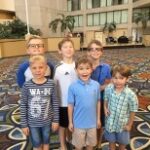
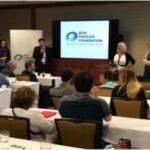
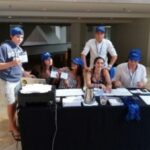
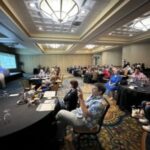
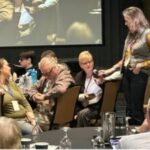
The BCMFF together with the Associazione Acromati Italiani onlus, started having European Meetings on Achromatopsia and Blue Cone Monochromacy. The first two European meetings took place in Mestre/Venice, Italy in 2018 and 2022, and several European Achromatopsia patients’ associations participated. Families from several European countries reached Mestre/Venice to spend 2 days together for both meetings.


Venice 2018 – Children playing together in the Meeting Children Room

In 2023, the Germany Achromatopsia Patients Association organized the Third European Meeting on Achromatopsia and Blue Cone Monochromacy in Tübingen, Germany.
 The Third European Meeting on Achromatopsia and Blue Cone Monochromacy – Tübingen, Germany, 2023
The Third European Meeting on Achromatopsia and Blue Cone Monochromacy – Tübingen, Germany, 2023
Patient Registry
In 2017 the BCM Families Foundation started the project of the BCM International Patient Registry, with Francesca Sofia of Science Compass, and Gian Marco Todesco and Digital Video. The Registry Manager, Sara Cammarota joined the project in 2021.
 Sara, the Registry Manager
Sara, the Registry Manager
Biotech companies
During the past 10 years the BCMFF collaborated with some biotech companies interested in developing a Gene Therapy for BCM, both AGTC and then Adverum Biotech.
NORD and Eurordis
In 2020 BCMFF became a Platinum member of NORD, the National Organization of the Rare Disorders (USA), and a Member of Eurordis (Europe).
Events
Numerous events have been organized by local Ambassadors, Angela M. Tucker, Mark Young, Nicole Kim, Trudi Dawson and Caspar Wohlfahrt, Julius Bolay to raise awareness and by directors and volunteers to find money for the cure. Every year Kay McCrary organizes the GivingTuesday Campaign, that is able to finance a large number of projects. Every year we participate to the Rare Disease Day with events. On Rare Disease Day 2021 the BCMFF lighted the Tryton fountain in Rome with Rare Disease Day colors.
 Rome – Bernini Tryton Fountain illuminated on Rare Disease Day for Blue Cone Monochromacy and Achromatopsia
Rome – Bernini Tryton Fountain illuminated on Rare Disease Day for Blue Cone Monochromacy and Achromatopsia
May 20th is the International Awareness Day for Blue Cone Monochromacy and we usually celebrate this event with campaigns for DNA test, BCM Patient Registry enrollment and webinars.
Founders and Directors
In the story of the BCMFF the following people, including Founder & President Renata Sarno, Ph.D. make an important difference: our directors, Kay McCrary, Barbara Sergent, Marylee Dilling and Ned Reade and John Cavitt, who served as Director from 2019 to 2023.
Significant Contributions by member volunteers
Dean Monthei contributes superb, specific firsthand advice about low vision tools advice. He also created an extremely useful Demo Glasses project in 2023.
Trudi Dawson writes a popular column of member interviews (« 60 Seconds with« ) in the BCMFF Newsletter.
Donors, including Monthly Donors, Year-End Donors, & Project Sponsor Donors, have made a HUGE meaningful difference that absolutely matters! Donors who give permission will be recognized in future newsletters.
 Dean Monthei
Dean Monthei
 Trudi Dawson
Trudi Dawson
A movement of dozens of volunteers now participates in all events and meetings and represents the true strength and richness of the BCMFF.
Relationship with other Patients Associations
During the past 10 years we have created relationships with other patients associations with shared symptoms and shared goals, in Europe notably with the Associazione Acromati Italiani and its President, Elisabetta Luchetta. In the USA, Director Kay McCrary is active in National Organization of Rare Disorders (NORD).
 Elisabetta Luchetta – Presidente Associazione Acromati Italiani
Elisabetta Luchetta – Presidente Associazione Acromati Italiani
Elisabetta Luchetta in Pingelap, bringing sunglasses to Pingelap children with Achromatopsia who hadn’t sunglasses previously
In 2019, with the Italian achromats association we participated in a trip to Pingelap: two members of our community, Paolo and Ferdinando, (third & fourth in the photo below) traveled, on behalf of BCMFF, to the Island of the Colorblind made famous by Oliver Sacks’s book.
 The team that in 2019 reached the Island of Colorblind, Pingelap, repeating the trip done by Oliver Sack and Knut Nordby
The team that in 2019 reached the Island of Colorblind, Pingelap, repeating the trip done by Oliver Sack and Knut Nordby
Conclusions
Our story and commitment to successfully finding #Cure4BCM does not end now. We recognize that we face a wonderful future of scientific and accessibility improvements as we travel this path.
Jupiter, FL – 2024




